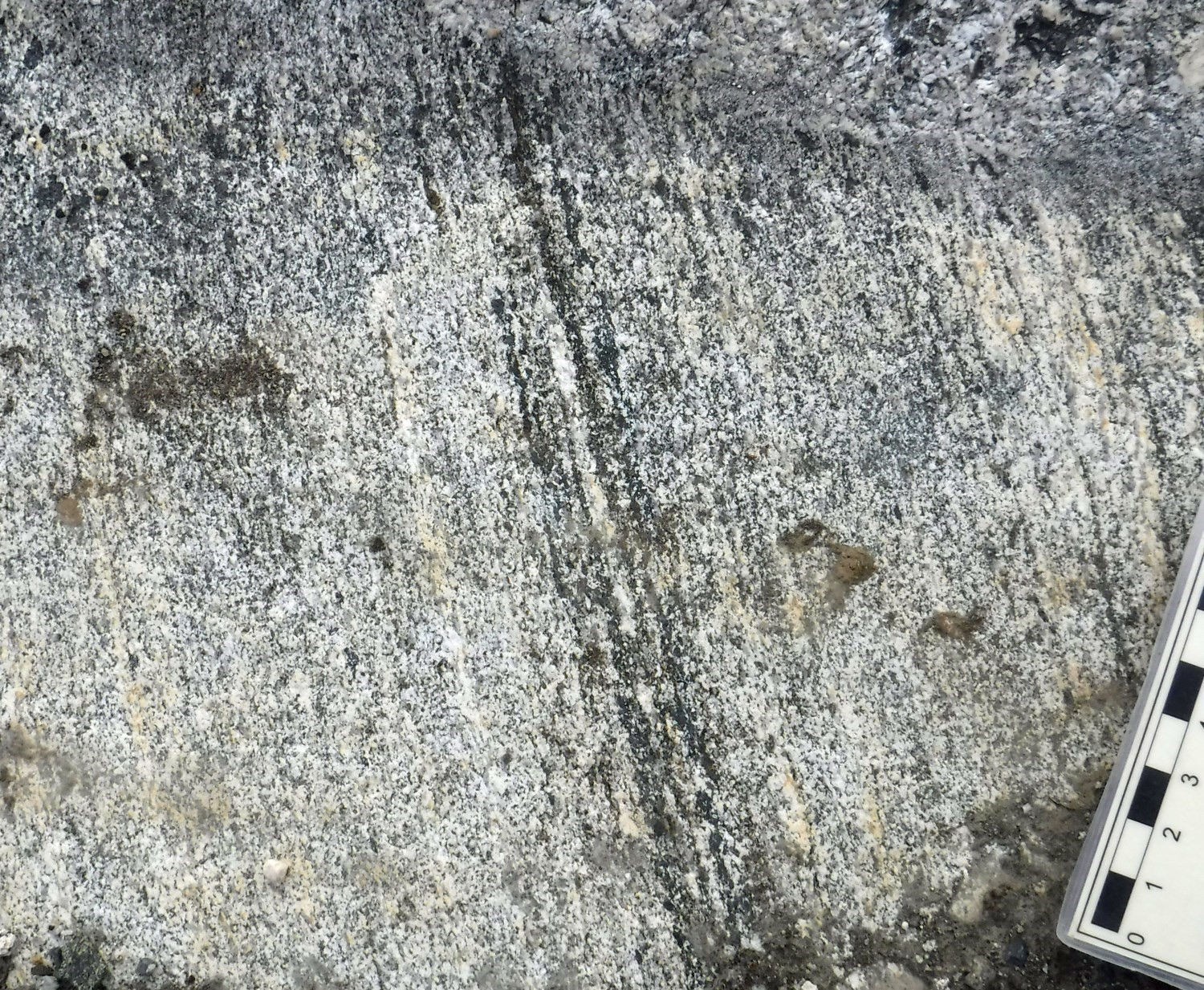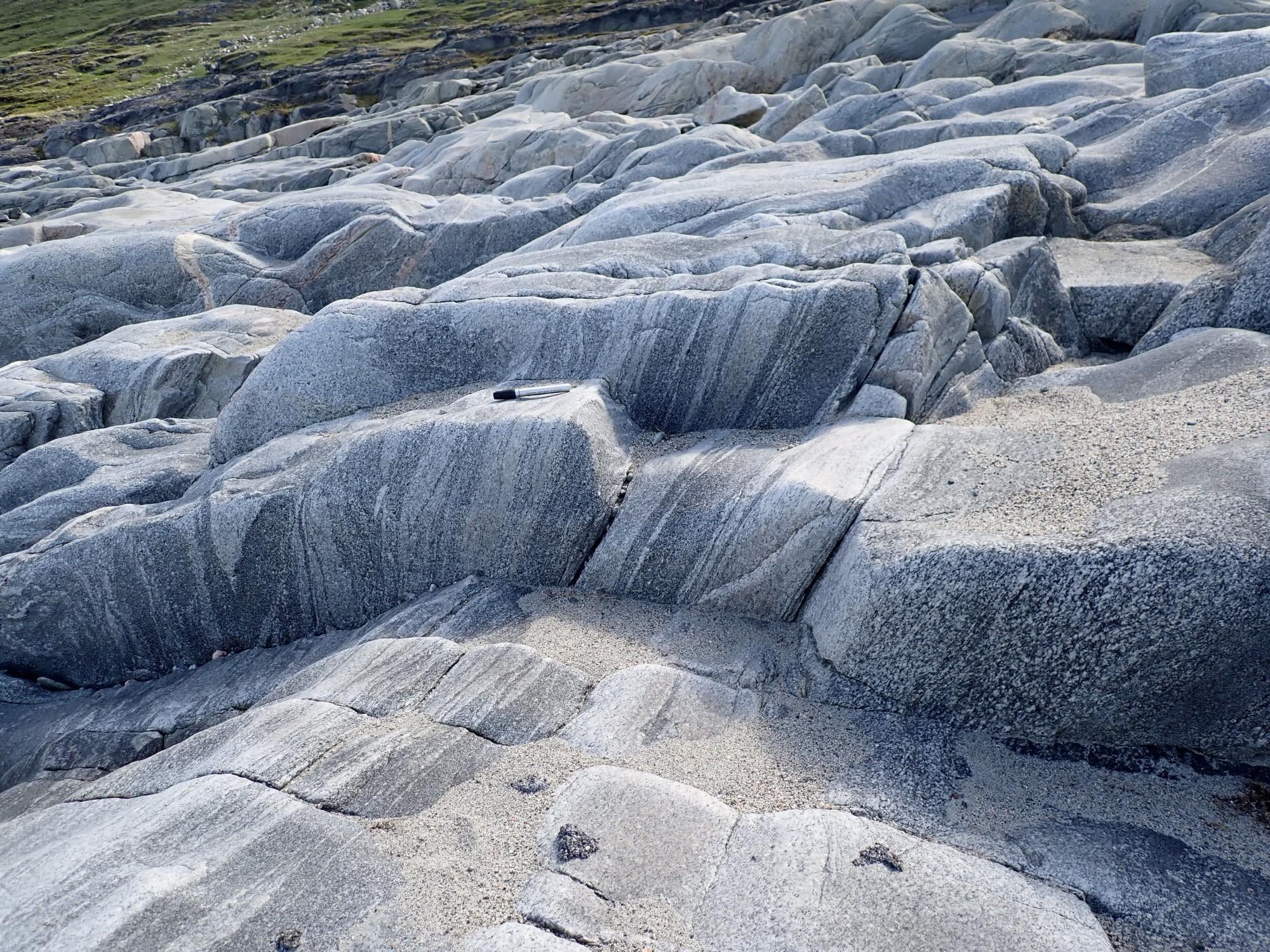
DISCLAIMER: This English version is translated from the original French. In case of any discrepancy, the French version shall prevail.
| Author: | Vanier and Lafrance, 2020 |
| Age: | Archean |
| Stratotype: | None |
| Type area: |
Guichaud River area (NTS sheet 35K01) Iqiattavialuk Lake area (NTS sheet 35K03) Reference outcrops 23-MV-1052 and 23-MV-1083 |
| Geological province: | Churchill Province |
| Geological subdivision: | Ungava Orogen / Kovik Lithotectonic Domain |
| Lithology: | Orthogneiss, tonalite, granodiorite and tonalite |
| Category: | Lithodemic |
| Rank: | Complex |
| Status: | Formal |
| Use: | Active |
None
Background
The Nanuk Complex was introduced in the Sirmiq Lake area (Vanier and Lafrance, 2020) in order to group felsic to intermediate gneissic or migmatitic rocks of the Kovik Lithotectonic Domain. It was extended southwards in the Lake Amarurtuup area (Lafrance et al., 2023), and eastwards in the Deception Bay area (Vanier and Bilodeau, 2024).It includes the gneissic or banded potassic intrusive rocks previously assigned to the Arviq Suite, in the Lake Sirmiq area (Vanier and Lafrance, 2020), as well as those assigned to the ApPkvk4, ApPkvk5 and ApPkvk6 units of the Kovik Complex, in the Cape Wolstenholme area (Charette and Beaudette, 2018).
Description
The Nanuk Complex consists of a group of Archean bedrock that are difficult to differentiate from the homogeneous tonalite and quartz diorite of the Uvikkaq Suite. The contacts between these two units, which are similar in composition, are diffuse or masked by lichen. Nanuk Complex rocks are distinguished by the presence of leucosome or gneissic banding. At the outcrop scale, the rock commonly changes from banded to homogeneous zones, suggesting the concomitant presence of the two units.The outcrops have been assigned to the dominant facies described in the field, but the transition between the Nanuk Complex rocks and those of the Uvikkaq Suite remains arbitrary.
The Nanuk Complex comprises three gneissic units in the Sirmiq and Amarurtuup lakes region: 1) a banded tonalite and diorite unit (Anuk1); 2) a banded granodiorite and monzogranite unit (Anuk2); and 3) a migmatitic rock unit (Anuk3). In addition to this, there are two minor subunits in the Deception Bay area: 4) a unit of amphibolitized gabbro and gabbronorite (Anuk4); and 5) a unit of banded amphibolite klippes and metasedimentary rocks (Anuk5). Unit Anuk3 is absent from this area.
Nanuk Complex 1 (Anuk1): Banded Tonalite and Quartz Diorite
The tonalite and quartz diorite are equigranular, medium to fine grained and well foliated. The rocks are medium to light grey. They have a banded appearance and display initial segregation of ferromagnesian and felsic minerals. This gneissosity is accentuated by the presence of 5-10% millimetric to centimetric whitish bands, possibly leucosome. More homogeneous decimetric layers without banding (similar to the Uvikkaq Suite tonalite) are commonly observed. Hornblende-biotite diorite is also observed in decimetric to centimetric layers. The leucosome has a larger grain size than the rest of the rock. It is in diffuse contact with tonalite or quartz diorite. It can also occur in clusters. Locally, it contains coarse hornblende crystals.
Tonalite and quartz diorite contain 8-28% quartz, <7% K-feldspar and 7-15% ferromagnesian minerals. Brown to green biotite is always in greater proportion than green hornblende, the latter may even be locally absent. Microcline is disseminated in fine interstitial crystals and these are more numerous in leucosome bands. In thin section, the general fabric is partially granoblastic to interlobed. Quartz forms large elongated crystals with undulatory extinction. Biotite is lepidoblastic and slightly chloritized. Epidote, sphene, opaque minerals, apatite, muscovite, monazite, allanite, carbonate and zircon are the accessory phases. Plagioclase is slightly sericitized.
Nanuk Complex 1a (Anuk1a): Biotite ± hornblende tonalite, quartz diorite bands, <20% granite injections, mafic enclaves
 Although it is the main unit on some outcrops, subunit Anuk1a is generally represented by decimetric to decametric layers within unit Anuk1 in the Lake Amarurtuup area (Lafrance et al., 2023).It can be distinguished from the Anuk1 unit by a well-defined rectilinear banding, consisting of alternating milimetric to centimetric bands of grey tonalite, white tonalite and dark grey quartz diorite. These lithologies are all fine-grained, equigranular and partially granoblastic.
Although it is the main unit on some outcrops, subunit Anuk1a is generally represented by decimetric to decametric layers within unit Anuk1 in the Lake Amarurtuup area (Lafrance et al., 2023).It can be distinguished from the Anuk1 unit by a well-defined rectilinear banding, consisting of alternating milimetric to centimetric bands of grey tonalite, white tonalite and dark grey quartz diorite. These lithologies are all fine-grained, equigranular and partially granoblastic.



 This orthogneiss subunit represents the dominant lithological sequence of the Nanuk Complex in the Deception Bay area.It is composed of banded biotite-hornblende tonalite. The percentage of bands varies greatly within this unit. They are mainly intermediate in composition. This unit also contains up to 20% of granitic injections parallel to subparallel to the foliation. Mafic enclaves are distributed heterogeneously in the unit, varying in proportion from 0 to 20% depending on the sector. These enclaves are transposed in the foliation.
This orthogneiss subunit represents the dominant lithological sequence of the Nanuk Complex in the Deception Bay area.It is composed of banded biotite-hornblende tonalite. The percentage of bands varies greatly within this unit. They are mainly intermediate in composition. This unit also contains up to 20% of granitic injections parallel to subparallel to the foliation. Mafic enclaves are distributed heterogeneously in the unit, varying in proportion from 0 to 20% depending on the sector. These enclaves are transposed in the foliation.
 The main minerals occurring in tonalite are quartz (20-40%) and plagioclase (40-70%). Microcline is generally not found in the unit, aside from a few areas where the percentage varies from 3 to 10%. Biotite is the most commonly observed secondary mineral, with its proportion varying from 3 to 15% depending on the sample. Biotite defines the characteristic lepidoblastic structure systematically observed in the unit.Fine subhedral hornblende (1-3%) is found in the interstices of plagioclase and quartz crystals. Accessory minerals are apatite and sphene, and to in lesser proportion epidote, allanite, opaque minerals, and finally muscovite and zircon.
The main minerals occurring in tonalite are quartz (20-40%) and plagioclase (40-70%). Microcline is generally not found in the unit, aside from a few areas where the percentage varies from 3 to 10%. Biotite is the most commonly observed secondary mineral, with its proportion varying from 3 to 15% depending on the sample. Biotite defines the characteristic lepidoblastic structure systematically observed in the unit.Fine subhedral hornblende (1-3%) is found in the interstices of plagioclase and quartz crystals. Accessory minerals are apatite and sphene, and to in lesser proportion epidote, allanite, opaque minerals, and finally muscovite and zircon.
Some alteration is noted in several samples, particularly with the presence of muscovite and sericite, interpreted as products of alteration of plagioclase. In the altered samples, the latter are beige with a milky appearance. Chlorite replaces biotite in several samples.
Fieldspar and quartz take the form of heterogranular and interlobed crystals. The grain size varies greatly, particularly in the case of quartz, which can be elongated and amoeboid, indicating grain boundary migration. The preferential axis of elongation is parallel to the one defined by the alignment of biotite. These quartz grains form pinch microstructures with biotite, which is commonly found in several samples
Nanuk Complex 1b (Anuk1b): Biotite-hornblende quartz diorite, bands of diorite, tonalite and gabbro, <20% granite injections
 The Anuk1b unit was first defined on the coast of Hudson Bay, north of the Kovik River (Charrette and Beaudette, 2018). It groups intermediate gneiss, characterized by alternating diorite and quartz diorite bands ranging in size from millimetric to centimetric. This subunit is commonly observed in transitional contact with Anuk1 tonalite and Anuk1a orthogneiss. Dioritic orthogneiss contains 5-10% of discontinuous leucosome bands ranging from a few millimetres to a few centimetres. Centimetric to decimetric gabbro layers are also observed locally. These mafic layers are locally boudinaged and generally represent <20% of the outcrop.
The Anuk1b unit was first defined on the coast of Hudson Bay, north of the Kovik River (Charrette and Beaudette, 2018). It groups intermediate gneiss, characterized by alternating diorite and quartz diorite bands ranging in size from millimetric to centimetric. This subunit is commonly observed in transitional contact with Anuk1 tonalite and Anuk1a orthogneiss. Dioritic orthogneiss contains 5-10% of discontinuous leucosome bands ranging from a few millimetres to a few centimetres. Centimetric to decimetric gabbro layers are also observed locally. These mafic layers are locally boudinaged and generally represent <20% of the outcrop.
Diorite bands contain 2-4% quartz and 25-40% ferromagnesian minerals. Quartz diorite bands contain 5-10% quartz and 20-25% ferromagnesian minerals. These bands are equigranular and fine grained, while plagioclase is granoblastic. Green hornblende is the dominant ferromagnesian mineral. It is either granoblastic or in crystals slightly coarser than plagioclase and interlobed. Biotite is commonly chloritized to varying degrees; complete chloritization is observed locally. Plagioclase is slightly sericitized. Epidote, sphene, opaque minerals and apatite are systematically present. Zircon and allanite are rarer.
 In the Deception Bay area, subunit Nanuk 1b consists of rocks similar to those described above, namely biotite ± hornblende gneissic quartz diorite with bands of diorite, tonalite and gabbro. This facies has been extended eastwards to regroup the rocks of gneissic appearance whose intermediate composition contrast with the majority of surrounding felsic rocks (Anuk1a) (Vanier and Bilodeau, 2024). This unit has a wide range of compositions, but the banded texture is fairly uniform. Both in fresh surface and in alteration patina, the rocks are light to dark grey in colour, locally whitish. The origin of most bands is uncertain. They are interpreted either as the result of mineral segregation caused by metamorphism, or as enclaves transposed into the gneissosity for mafic bands.
In the Deception Bay area, subunit Nanuk 1b consists of rocks similar to those described above, namely biotite ± hornblende gneissic quartz diorite with bands of diorite, tonalite and gabbro. This facies has been extended eastwards to regroup the rocks of gneissic appearance whose intermediate composition contrast with the majority of surrounding felsic rocks (Anuk1a) (Vanier and Bilodeau, 2024). This unit has a wide range of compositions, but the banded texture is fairly uniform. Both in fresh surface and in alteration patina, the rocks are light to dark grey in colour, locally whitish. The origin of most bands is uncertain. They are interpreted either as the result of mineral segregation caused by metamorphism, or as enclaves transposed into the gneissosity for mafic bands.
 The rocks in this region contain a large proportion of plagioclase, ranging from 60 to 78%. Ferromagnesian minerals are more abundant than in other subfacies of the unit, but are found in highly variable concentrations. There are 3-22% of biotite in lepidoblastic clusters and 2-18% of fine interstitial hornblende between plagioclase crystals, in isolated coarse crystals or in poikilitic porphyroblasts. The speckled structure is demonstrated by plagioclase clusters, ferromagnesian mineral clusters and medium to coarse hornblende crystals, isolated in a plagioclase matrix.
The rocks in this region contain a large proportion of plagioclase, ranging from 60 to 78%. Ferromagnesian minerals are more abundant than in other subfacies of the unit, but are found in highly variable concentrations. There are 3-22% of biotite in lepidoblastic clusters and 2-18% of fine interstitial hornblende between plagioclase crystals, in isolated coarse crystals or in poikilitic porphyroblasts. The speckled structure is demonstrated by plagioclase clusters, ferromagnesian mineral clusters and medium to coarse hornblende crystals, isolated in a plagioclase matrix.
 Dioritic bands contain more biotite and hornblende, accentuating the lepidoblastic texture when compared with more felsic bands. Le quartz est aussi présent en proportion très variable dans cette unité, soit de 2 à 15 %. K-feldspar is generally absent from most samples, with some exceptions containing up to 8%. The main accessory minerals observed under the microscope are sphene and apatite, followed by epidote, opaque minerals, zircon and monazite. Allanite, present in fairly coarse crystals ranging in diameter from a few millimetres to 0.5 cm, is commonly coronitic and surrounded by or included in epidote. Biotite is associated with magnetite.
Dioritic bands contain more biotite and hornblende, accentuating the lepidoblastic texture when compared with more felsic bands. Le quartz est aussi présent en proportion très variable dans cette unité, soit de 2 à 15 %. K-feldspar is generally absent from most samples, with some exceptions containing up to 8%. The main accessory minerals observed under the microscope are sphene and apatite, followed by epidote, opaque minerals, zircon and monazite. Allanite, present in fairly coarse crystals ranging in diameter from a few millimetres to 0.5 cm, is commonly coronitic and surrounded by or included in epidote. Biotite is associated with magnetite.
As with other facies, granitic injections or bands are only seen locally, particularly near granitic intrusions. These bands are interpreted as sills injected parallel to the gneissosity. The feldspars and quartz are granoblastic, with varied morphologies, generally heterogranular and with interlobed contacts. Several samples show signs of more advanced recrystallization with very varied grain sizes or, to a lesser extent, clusters of polygonal crystals.
Nanuk Complex 1c (Anuk1c): Biotite ± hornblende tonalite, quartz diorite and diorite, >20% granite injections

 This subunit is composed of a biotite ± hornblende tonalite and quartz diorite similar to units Anuk1a and 1b described above. This facies was introduced to group Nanuk outcrops containing >20% granitic bands. The bands are beige or pinkish in colour and typically hololeucocratic, since they contain very few ferromagnesian minerals. The origin of most of these bands is uncertain, possibly resulting from a mineral segregation of metamorphic origin. A smaller proportion of bands are considered to be sills injected parallel to the foliation. Planar and linear fabrics associated with successive episodes of deformation have affected the initial morphology of the bands. As a result, many of them are deformed and show a diffuse porphyroid texture.
This subunit is composed of a biotite ± hornblende tonalite and quartz diorite similar to units Anuk1a and 1b described above. This facies was introduced to group Nanuk outcrops containing >20% granitic bands. The bands are beige or pinkish in colour and typically hololeucocratic, since they contain very few ferromagnesian minerals. The origin of most of these bands is uncertain, possibly resulting from a mineral segregation of metamorphic origin. A smaller proportion of bands are considered to be sills injected parallel to the foliation. Planar and linear fabrics associated with successive episodes of deformation have affected the initial morphology of the bands. As a result, many of them are deformed and show a diffuse porphyroid texture.
Nanuk Complex 2 (Anuk2): Biotite ± Magnetite Banded, Porphyroid or Speckled Granodiorite and Biotite Schlierens
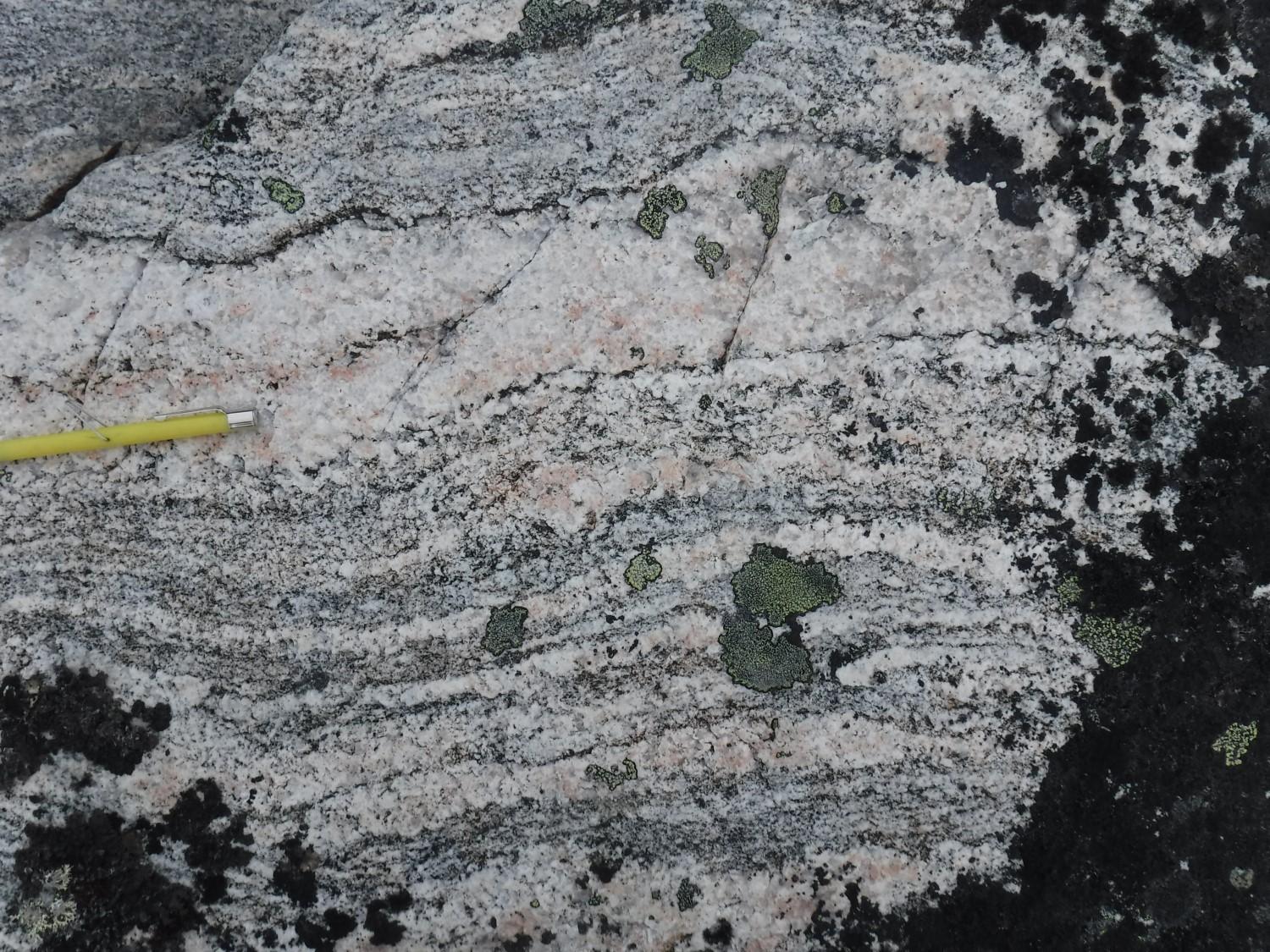 In outcrop, unit Anuk2 can be difficult to distinguish from unit Anuk1. It can be distinguished by a slightly lighter colour and the scarcity of hornblende, but above all by the common presence of a coarse-grained pink granite facies injected into granodiorite or monzogranite. These injections are visible in the form of millimetric to centimetric bands subparallel to the foliation or intersecting at a slight angle. Granodiorite and monzogranite are equigranular and medium to fine grained. These rocks also contain up to 15% whitish to pinkish leucosome and decimetric dioritic layers.
In outcrop, unit Anuk2 can be difficult to distinguish from unit Anuk1. It can be distinguished by a slightly lighter colour and the scarcity of hornblende, but above all by the common presence of a coarse-grained pink granite facies injected into granodiorite or monzogranite. These injections are visible in the form of millimetric to centimetric bands subparallel to the foliation or intersecting at a slight angle. Granodiorite and monzogranite are equigranular and medium to fine grained. These rocks also contain up to 15% whitish to pinkish leucosome and decimetric dioritic layers.
Anuk2 rocks contain 20-30% quartz, 25-35% K-feldspar and 5-15% ferromagnesian minerals. The latter are dominated by biotite, while hornblende is rarely present. Under the microscope, the general fabric is partially granoblastic to interlobed. K-feldspar consists mainly of microcline and myrmekites are common. Quartz exhibits undulatory extinction and is observed locally as subgrains. Biotite is lepidoblastic and partially chloritized. Accessory minerals include epidote, apatite, allanite, opaque minerals, sphene and zircon.

 In the Deception Bay area, this subunit consists mainly of banded granodiorite with a gneissic appearance and a light grey colour. Main minerals are in highly variable proportions due to the uneven percentage of bands. Its generally more potassic composition, the fine to coarse grain size and the presence of smoky quartz are characteristics that distinguish it from the main unit Anuk1. Granodiorite contains beige to pinkish feldspar bands, typically low in quartz and ferromagnesian minerals. These bands are interpreted as the result of a mineral segregation of metamorphic origin.
In the Deception Bay area, this subunit consists mainly of banded granodiorite with a gneissic appearance and a light grey colour. Main minerals are in highly variable proportions due to the uneven percentage of bands. Its generally more potassic composition, the fine to coarse grain size and the presence of smoky quartz are characteristics that distinguish it from the main unit Anuk1. Granodiorite contains beige to pinkish feldspar bands, typically low in quartz and ferromagnesian minerals. These bands are interpreted as the result of a mineral segregation of metamorphic origin.

 Rocks are composed of 25-40% quartz, 10-50% plagioclase, 5-50% microcline and 5-10% orthoclase, depending on the sample. Recrystallized microcline phenocrysts occur in isolation, accompanied by clusters of very fine-grained microcline in the pressure shadows of these phenocrysts. Feldspars are generally damouritized and locally perthitic. Myrmekites are observed in some samples. Ferromagnesian minerals include biotite (3-7%) and hornblende (0-1%). The distribution of biotite schlieren also varies within the unit. Like the bands, schlierens define the gneissosity of the rock. The biotite they contain appears to predate the main fabric. This biotite is partially replaced by chlorite in some samples. Accessory minerals include magnetite, apatite and muscovite, which account for no more than 1% of the rock. Other minerals observed locally are sphene, epidote, allanite and zircon. Under the microscope, minerals appear to be highly recrystallized, as evidenced by their highly complex amoeboid morphology and wide range of grain sizes. Quartz forms pinch figures with biotite in schlieren-bearing zones, and clusters of subgrains form chessboards in some samples.
Rocks are composed of 25-40% quartz, 10-50% plagioclase, 5-50% microcline and 5-10% orthoclase, depending on the sample. Recrystallized microcline phenocrysts occur in isolation, accompanied by clusters of very fine-grained microcline in the pressure shadows of these phenocrysts. Feldspars are generally damouritized and locally perthitic. Myrmekites are observed in some samples. Ferromagnesian minerals include biotite (3-7%) and hornblende (0-1%). The distribution of biotite schlieren also varies within the unit. Like the bands, schlierens define the gneissosity of the rock. The biotite they contain appears to predate the main fabric. This biotite is partially replaced by chlorite in some samples. Accessory minerals include magnetite, apatite and muscovite, which account for no more than 1% of the rock. Other minerals observed locally are sphene, epidote, allanite and zircon. Under the microscope, minerals appear to be highly recrystallized, as evidenced by their highly complex amoeboid morphology and wide range of grain sizes. Quartz forms pinch figures with biotite in schlieren-bearing zones, and clusters of subgrains form chessboards in some samples.
Nanuk Complex 2a (Anuk2a): Granitic orthogneiss
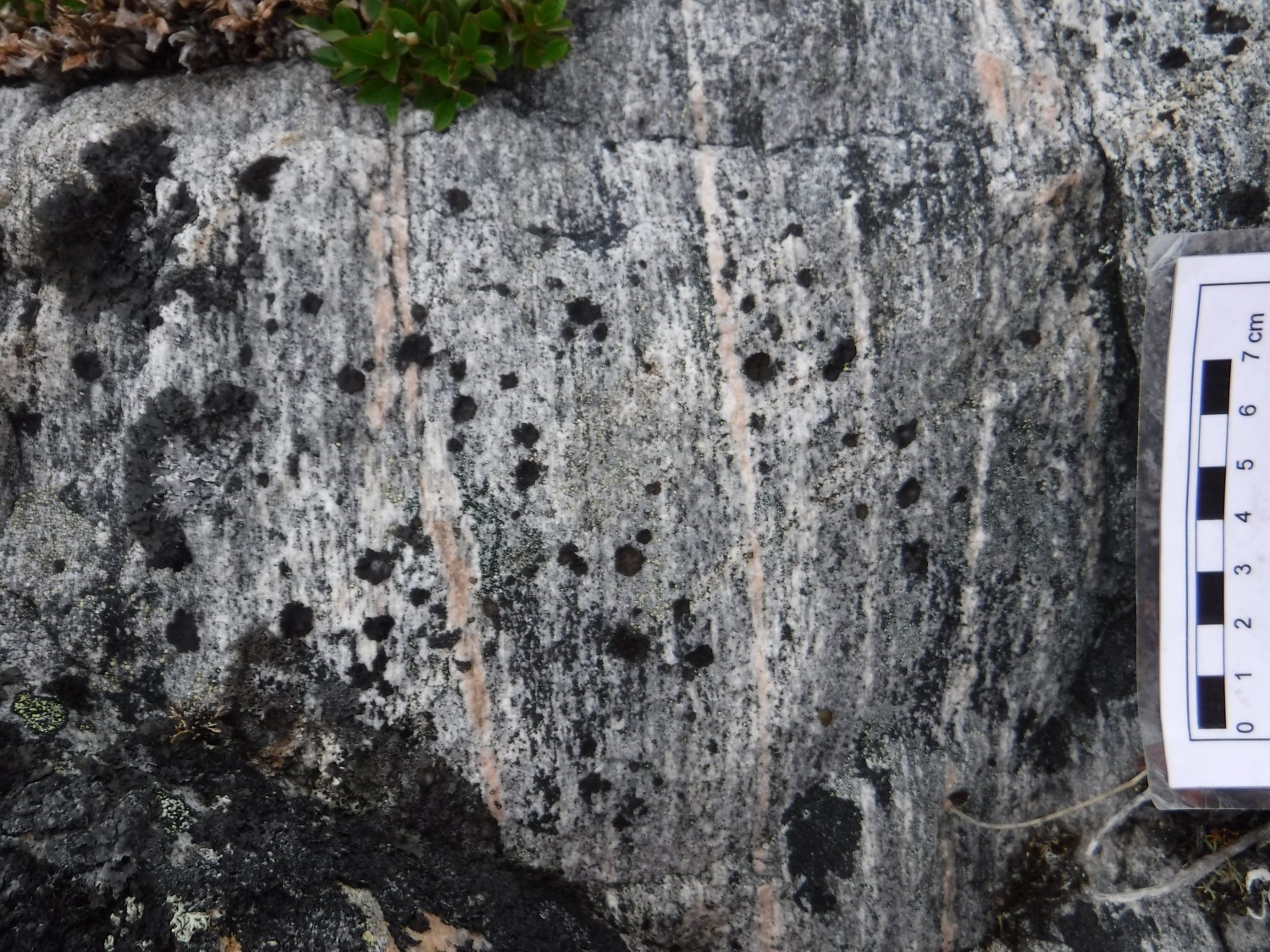 Like the Anuk1a subunit, the Anuk2b orthogneiss, characterized by rectilinear banding, forms decimetric to decametric layers within the unit Anuk2. The composition of the bands, which alternate from millimetric to centimetric, is granitic and locally granodioritic. The bands are either grey, pink or white. The rocks are equigranular and fine grained.
Like the Anuk1a subunit, the Anuk2b orthogneiss, characterized by rectilinear banding, forms decimetric to decametric layers within the unit Anuk2. The composition of the bands, which alternate from millimetric to centimetric, is granitic and locally granodioritic. The bands are either grey, pink or white. The rocks are equigranular and fine grained.
Nanuk Complex 3 (Anuk3): Migmatitic Rocks
In some areas, rocks from the Anuk1 and Anuk2 units have undergone significant partial melting. They have therefore been assigned to the Anuk3 unit. It should be noted that the transition between these units is generally gradual and that the boundary between them is arbitrary. The degree of melting varies greatly.
In thin sections, the grains have a serial distribution and an interlobed shape. Quartz is amoeboid with undulatory extinction and forms subgrains. Ferromagnesian minerals (10-20%) consist of similar proportions of brown to green biotite and green hornblende. Hornblende is locally replaced by a mixture of chlorite-epidote-carbonate. Biotite is variably chloritized and locally intergrown with quartz. Plagioclase is slightly sericitized and in places contains muscovite inclusions in sheets. Epidote, apatite, allanite, zircon, sphene and opaque minerals are present in minor proportions.
Nanuk Complex 3a (Anuk3a): Stromatic metatexite
 The Anuk3a metatexite is stromatic. The leucosome is generally whitish and medium to coarse grained. It forms centimetric undulatory bands that are commonly folded. Its composition varies from tonalitic to granodioritic or granitic. The palaeosome is similar to that of the Anuk1 and Anuk2 units. At the edge of the leucosome, the ferromagnesian minerals are coarser. These commonly form millimetric to centimetric clusters.
The Anuk3a metatexite is stromatic. The leucosome is generally whitish and medium to coarse grained. It forms centimetric undulatory bands that are commonly folded. Its composition varies from tonalitic to granodioritic or granitic. The palaeosome is similar to that of the Anuk1 and Anuk2 units. At the edge of the leucosome, the ferromagnesian minerals are coarser. These commonly form millimetric to centimetric clusters.
Nanuk Complex 3b (Anuk3b): Schlieren diatexite
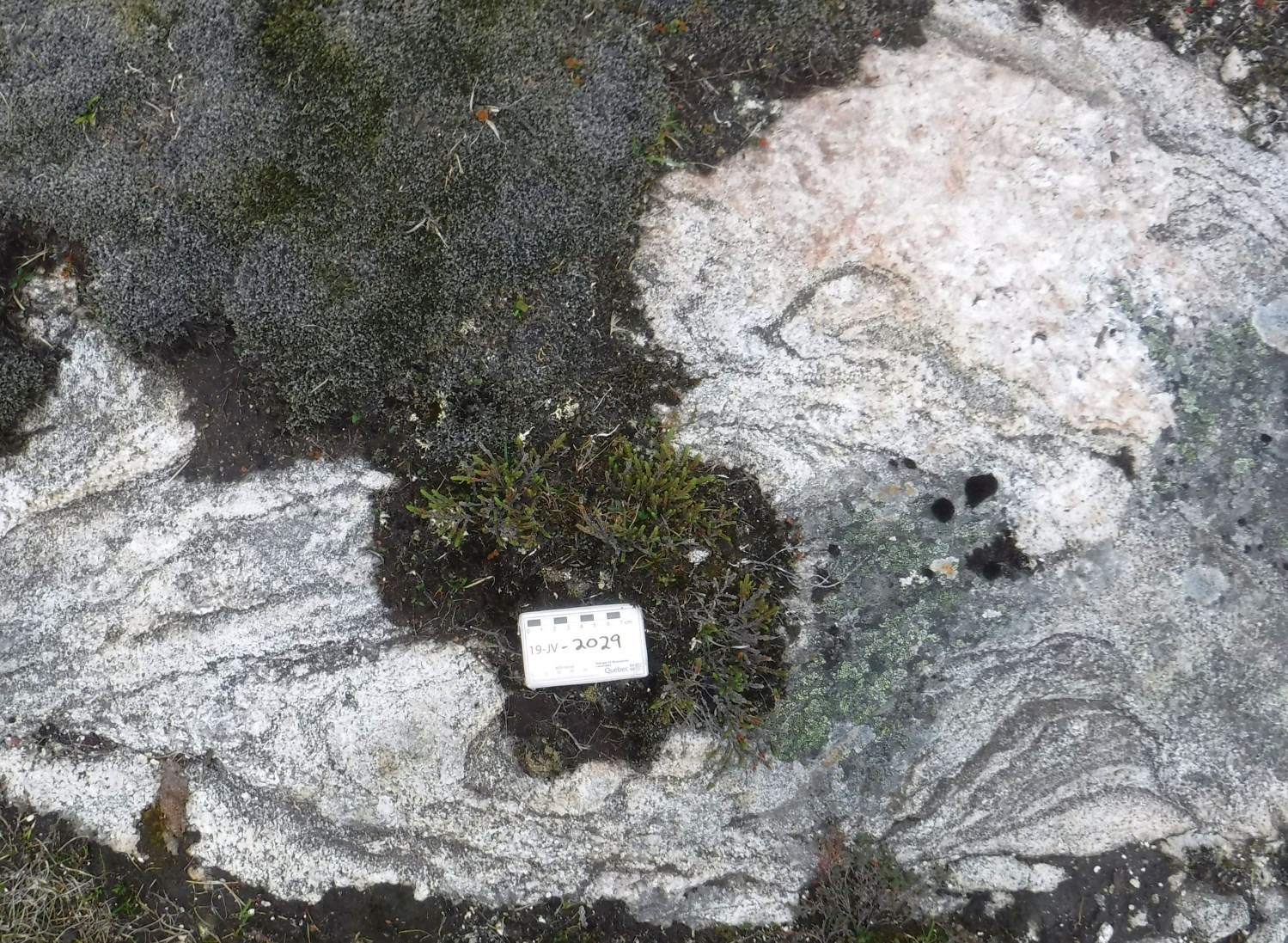
 Many areas contain an even higher proportion of leucosome. These migmatites have a heterogeneous appearance and contain a high proportion of whitish anatectic granite. In outcrops where banding is present, it is rather chaotic. Raft structures and schlieren are common. The rafts are generally decimetric to metric and their composition is similar to that of the Anuk1 and Anuk2 units. Ferromagnesian minerals (hornblende and biotite) are concentrated in schlieren that weakly mark the foliation.
Many areas contain an even higher proportion of leucosome. These migmatites have a heterogeneous appearance and contain a high proportion of whitish anatectic granite. In outcrops where banding is present, it is rather chaotic. Raft structures and schlieren are common. The rafts are generally decimetric to metric and their composition is similar to that of the Anuk1 and Anuk2 units. Ferromagnesian minerals (hornblende and biotite) are concentrated in schlieren that weakly mark the foliation.
Nanuk Complex 3c (Anuk3c): Clusters of leucosome diatexite
 In Anuk3c migmatites, leucosome occurs in centimetric clusters (patchy migmatite). These clusters are slightly coarser than the surrounding rock with which they are in diffuse contact. This texture is difficult to distinguish in outcrop, and the rocks of unit Anuk3c can be easily confused with the homogeneous tonalite and quartz diorite of the Uvikkaq Suite.
In Anuk3c migmatites, leucosome occurs in centimetric clusters (patchy migmatite). These clusters are slightly coarser than the surrounding rock with which they are in diffuse contact. This texture is difficult to distinguish in outcrop, and the rocks of unit Anuk3c can be easily confused with the homogeneous tonalite and quartz diorite of the Uvikkaq Suite.
Nanuk Complex 4 (Anuk4): Amphibolitized Gabbro and Gabbronorite, Locally Containing Garnet or Biotite
This subunit comprises enclaves and boudins of mafic intrusive rocks mappable within gneissic units of the Nanuk Complex (Anuk1a, 1b, 1c and 2), in the Deception Bay area (Vanier and Bilodeau, 2024). These geological bodies have been observed in several outcrops, but given their relatively modest size, they rarely appear on regional-scale geological maps. Mappable features form isolated megaboudins or multi-decametric rafts, enveloped by the gneissosity of surrounding rocks. The rocks have the same composition as metamorphosed gabbro and gabbronorite. They are brown to dark grey-green in fresh fracture and greenish-beige or greenish-brown to blackish in alteration patina. Rock composition varies widely, with hornblende and plagioclase dominating the mineralogy, followed locally by garnet, clinopyroxene and orthopyroxene. Mineral proportions generally vary significantly. In general, mineral proportions vary markedly. The rock is granoblastic, generally equigranular and medium grained. No crosscutting relationships have been reported between the different facies. The rocks are not magnetic.
Nanuk Complex 5 (Anuk5): Banded and Migmatized Amphibolite, Paragneiss, Minor Proportion of Quartzite and Calc-silicate Rock.
Unit Anuk5 is made up of amphibolite and paragneiss klippes found in units Anuk1a, 1b and 2.
Nanuk Complex 5a (Anuk5a): banded and migmatized amphibolite, layers of migmatized garnet ± sillimanite paragneiss
A few layers of amphibolitized and partially migmatized mafic metavolcanic rocks have been identified on the coast of the Hudson Strait, in the Deception Bay area (Vanier and Bilodeau, 2024). These rocks are strongly deformed. They form tabular bodies that match the gneissosity of surrounding lithologies. They are black to very dark green in fresh fracture and green and white to very dark green in alteration patina. These rocks are mainly composed of hornblende and plagioclase. They also contain variable percentages of coronitic garnet and clinopyroxene, in addition to biotite, quartz and opaque minerals in accessory proportions. Amphibolite has a fine to medium grain size and is characterized by a banded appearance, which is evidenced by variations in composition, colour and grain size. A small percentage of mobilisate, a product of partial melting of the unit, is present in outcrops of this subunit. The mobilisate consists of small feldspathic clusters exhibiting a stromatic structure. The amphibolite contains small layers of slightly migmatitic grey-brown biotite-garnet-sillimanite paragneiss.
Nanuk Complex 5b (Anuk5b): Biotite ± garnet ± sillimanite ± kyanite ± cordierite paragneiss, minor proportion of quartzite and calc-silicate rock
This subunit brings together the mappable klippes of metasedimentary rocks identified within the gneissic units of the Nanuk Complex, in the Deception Bay area (Vanier and Bilodeau, 2024). These rocks form tabular and folded bodies up to 150 m thick. They have been observed in several outcrops, but given their relatively small size, they rarely appear on regional-scale geological maps. The main lithology of this unit consists of a biotite paragneiss and, secondarily, various aluminosilicates such as garnet, sillimanite, kyanite and cordierite.
Thickness and Distribution
The Nanuk Complex is one of the main units of the Kovik Lithotectonic Domain. It mainly forms an elongated structure >145 km long and 30 km wide to the south of the Sugluk Shear Zone (sheets 35F13 to 35F16). It also forms bands a few hundred metres to a few kilometres wide oriented NE-SW to NW-SE outside this elongated structure. Its eastward extension has been defined to the western shore of Deception Bay and extends under the waters of the Hudson Strait to the north (Vanier and Bilodeau, 2024). The size and thickness of the subunits are difficult to assess. Klippes of amphibolite and paragneiss attributed to the Nanuk Complex (Anuk5) form bodies that are interpreted as enclaves of highly variable dimensions, the majority of which cannot be mapped at the scale used in the region.
Dating
Archean ages obtained from samples collected from outcrops 2021-IL-2132 and 2021-IL-3106 are interpreted by Davis (2023) as indicating the location of an Archean pluton, around 2700 Ma, derived from a basement with an age of ~2800 Ma. Ages around 2700 Ma could also be associated with an episode of Archean metamorphism (Lafrance et al., 2023) that affected rocks emplaced between 2831 Ma and 2770 Ma.
| Unit | Sample | Isotopic System | Mineral | Crystallization Age (Ma) | (+) | (-) | Inherited Age (Ma) | (+) | (-) | Metamorphic Age (Ma) | (+) | (-) | Reference(s) |
| Anuk1 | 2021-IL-3132A | U-Pb | Zircon | 2700 | 5 | 5 | 2.8 Ga | Davis, 2023 | |||||
| Anuk3c | 2021-IL-3106A | U-Pb | Zircon | 2705 | 3 | 3 |
2802 2770 |
4 5 |
4 5 |
||||
| Anuk2 | 2017-MP-1059A | U-Pb | Zircon | 2831 | 11 | 11 | 1828 | 17 | 17 | Davis, 2022 | |||
| Monazite | 1801 | 10 |
Stratigraphic Relationship(s)
Units of the Nanuk Complex are locally intruded by coarse to pegmatitic granite, possibly associated with the Nunatak Suite. These intrusions were emplaced as dykes or centimetric to decimetric bands subparallel to foliation. The Nanuk Complex also contains decimetric layers of tonalite from the Uvikkaq Suite, although contacts between these two units are diffuse.
In the Deception Bay area, the Nanuk and Deception (Adec) complexes represent a package of Archean units that underlie the Proterozoic units in the region (Vanier and Bilodeau, 2024). Contacts between the two domains are interpreted as being intrusive in nature, and subsequently reoriented by successive folding phases. Part of the Nanuk supports the erosional unconformable contact between the metavolcanic and metasedimentary rocks of the Crony Metamorphic Suite (pPcry) and the associated mafic intrusive rocks, namely the Serpentine (pPsrt) and Gastrin (pPgan) suites. Crosscutting relationships observed in this area indicate that the Nanuk Complex is cut by the Maurepas (Amrp) ,Arviq (pPavi3 ) and Nunatak (pPnat) granitic suites.
Paleontology
Does not apply.
References
Publications Available Through SIGÉOM Examine
CHARETTE, B., BEAUDETTE, M., 2018. Géologie de la région du cap Wolstenholme, Orogène de l’Ungava, Province de Churchill, sud-est d’Ivujivik, Québec, Canada. MERN; BG 2018-03, 2 plans.
DAVIS, D.W., 2022. Rapport sur les datations U-Pb de roches du Québec 2019-2020. UNIVERSITY OF TORONTO, MERN; MB 2021-03, 192 pages.
DAVIS, D.W., 2023. Rapport sur les datations U-Pb de roches du Québec 2021-2022. UNIVERSITY OF TORONTO, MRNF; MB 2023-02, 201 pages.
LAFRANCE, I., VANIER, M.-A., GÉLINAS, T.K., 2023. Géologie de la région d’Amarurtuuq, Orogène de l’Ungava, Nunavik, Québec, Canada. MERN; BG 2023-08, 1 plan.
VANIER, M.-A., BILODEAU, C., 2024. Géologie de la région de la baie Déception, Orogène de L’Ungava, Nunavik, Québec, Canada. MRNF; BG 2023-09, 1 plan.
VANIER, M.-A., LAFRANCE, I., 2020. Géologie de la région du lac Sirmiq, Orogène de l’Ungava, Nunavik, Québec, Canada. MERN; BG 2020-02, 1 plan.
Suggested Citation
Ministère des Ressources naturelles et des Forêts (MRNF). Nanuk Complex. Quebec Stratigraphic Lexicon. https://gq.mines.gouv.qc.ca/lexique-stratigraphique/province-de-churchill/complexe-de-nanuk_en [accessed on Day Month Year].
Contributors
|
First publication |
Isabelle Lafrance, P. Geo., M.Sc. isabelle.lafrance@mern.gouv.qc.ca; Marc-Antoine Vanier, Jr. Eng., M.Sc. marc-antoine.vanier@mern.gouv.qc.ca (redaction) Mehdi A. Guemache, P. Geo., Ph.D. (coordination); Benoit Charette, P. Geo., M.Sc. (critical review); Simon Auclair, P. Geo., M.Sc. (editing); Céline Dupuis, P. Geo., Ph.D. (English version); Yan Carette (HTML editing). |
|
Revision(s) |
Carl Bilodeau, P. Geo., M.Sc. carl.bilodeau@mrnf.gouv.qc.ca (redaction: Novembre 15th, 2024) Philippe Pagé, P. Geo., Ph.D. (coordination); James Moorhead, P. Geo., M.Sc. et Philippe Pagé, P. Geo., Ph.D. (critical review); Simon Auclair, P. Geo., M.Sc. (editing); Catherine Tremblay (English version); André Tremblay (HTML editing). |


